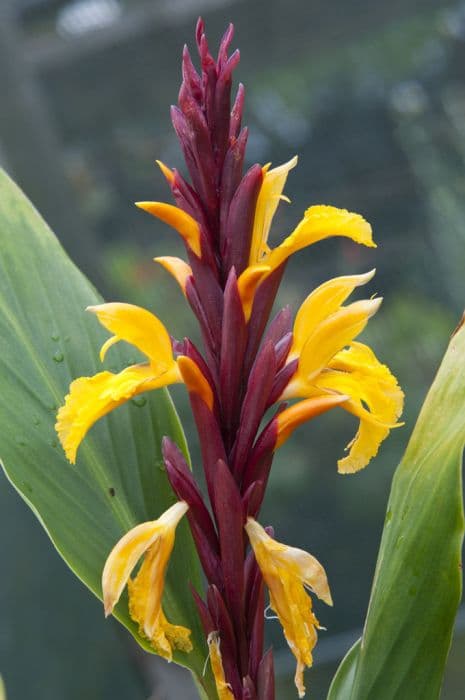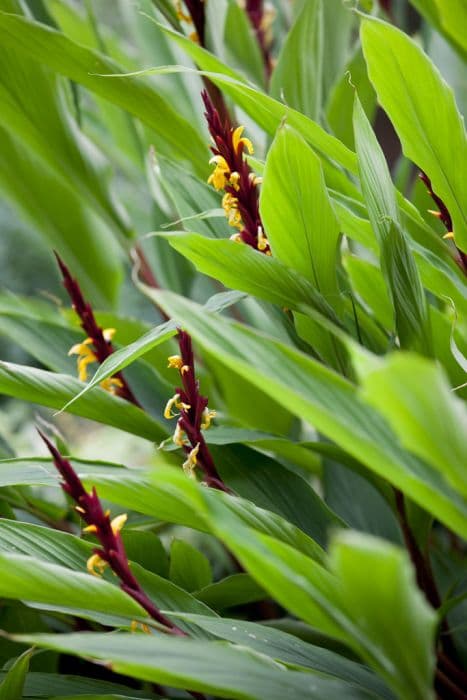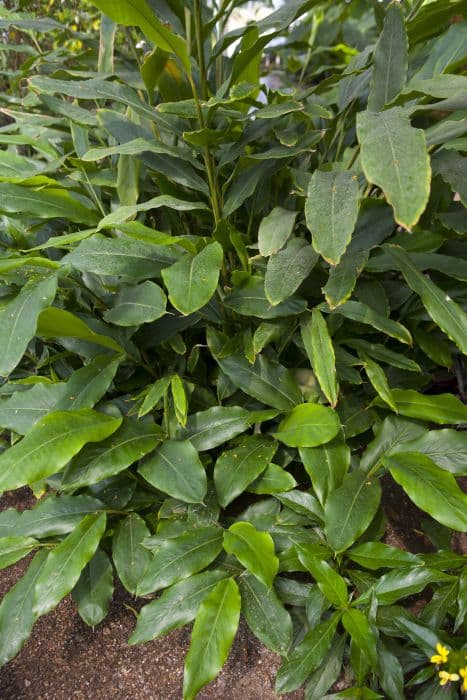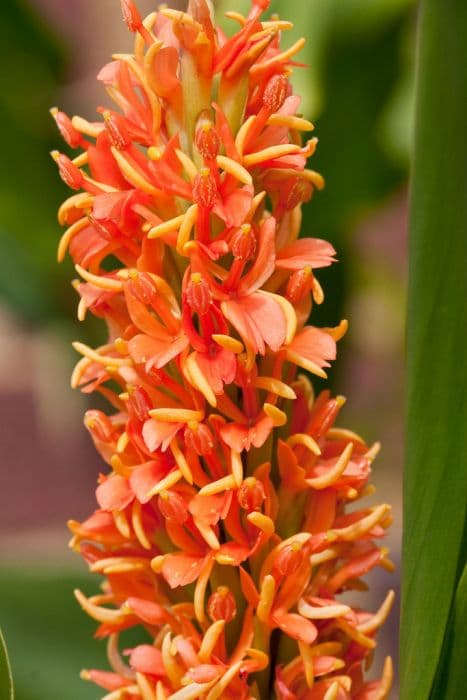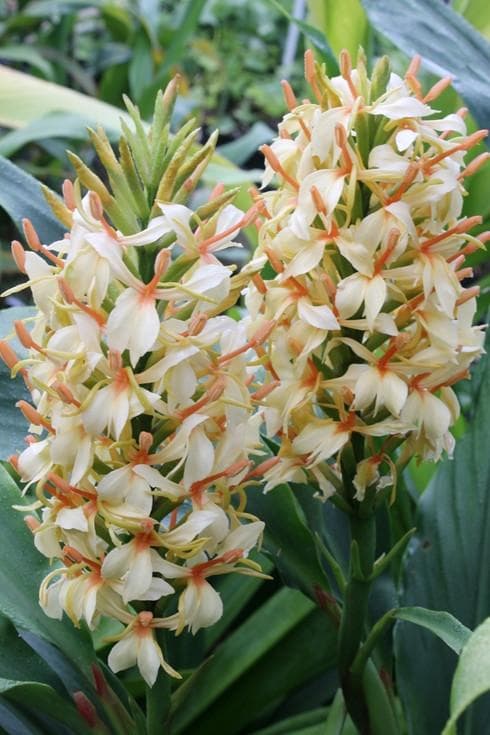Red Ginger Lily Roscoea purpurea f. rubra

ABOUT
Roscoea purpurea f. rubra, commonly known as the red ginger lily, presents a captivating visual with its vibrant floral display and lush foliage. The most striking feature of this plant is its conspicuous flowers, which boast a deep reddish-purple hue, evoking a sense of exoticism and elegance. Each flower has a delicate, tubular shape with a slightly flared lip, inviting pollinators to visit. The red ginger lily's petals may possess a velvety texture, enriching the visual allure with a tactile dimension. Surrounding the flowers, the foliage is also noteworthy for its contribution to the overall appearance of the plant. The leaves are typically elongated and lance-shaped, with a glossy surface that contrasts beautifully against the floral coloration. The rich green color of the leaves establishes a lush backdrop that highlights the intense reds and purples of the blossoms. Together, the combination of striking flowers and robust foliage renders the red ginger lily a specimen of considerable ornamental appeal, making it a desirable addition to gardens and landscapes where it can be accommodated by the climate. Additionally, the leaves emerge from the base of the plant, forming a clump that helps to create a sense of fullness and volume. While the detailed structures of the flowers, including the specific shapes and patterns of the petals, contribute to the red ginger lily's exotic appearance, the plant exudes a tropical vibe that can infuse a garden space with an air of lushness and vibrant color. Overall, the red ginger lily’s appearance is a harmonious blend of vivid coloration and graceful structure.
About this plant
 Names
NamesSynonyms
Red Ginger Lily, Purple Roscoea, Red Roscoea
Common names
Roscoea purpurea var. rubra
 Toxicity
ToxicityTo humans
There are no well-documented cases of toxicity in humans from the ingestion of Roscoea purpurea, commonly known as Red Himalayan ginger. As such, there is no specific information available on symptoms of poisoning from this plant. However, it is always advisable to exercise caution and avoid ingesting plants or plant parts if their edibility or toxicity is uncertain.
To pets
Similar to its effects on humans, there is no specific information available on the toxicity of Red Himalayan ginger to pets. It is not commonly reported as a toxic plant to pets. Nevertheless, pet owners should prevent pets from ingesting plants that are not confirmed to be safe. If a pet accidentally consumes Roscoea purpurea and shows any signs of illness, it is recommended to consult a veterinarian.
 Characteristics
CharacteristicsLife cycle
Perennials
Foliage type
Deciduous
Color of leaves
Green
Flower color
Purple
Height
1-2 feet (30-60 cm)
Spread
1 foot (30 cm)
Plant type
Herb
Hardiness zones
6
Native area
Asia
Benefits
 General Benefits
General Benefits- Aesthetic Value: Roscoea purpurea f. rubra, commonly known as Red Ginger Roscoea, adds vibrant color and exotic beauty to gardens with its striking red flowers.
- Attracts Pollinators: The blossoms of the Red Ginger Roscoea are a natural attraction for bees, butterflies, and other pollinating insects, which is beneficial for the health of the local ecosystem.
- Low Maintenance: This plant is known for being relatively easy to care for, requiring minimal attention once established, making it ideal for both novice and experienced gardeners.
- Cold Hardy: The Red Ginger Roscoea is surprisingly cold-hardy for an exotic-looking plant, expanding the range of climates where it can be successfully cultivated.
- Shade Tolerance: It can thrive in partial shade, providing flexibility in garden design and the potential to brighten up less sunny areas.
- Perennial Growth: As a perennial, the plant returns year after year, providing consistent and long-lasting splendor to a garden space.
 Medical Properties
Medical Properties- Anti-inflammatory: Roscoea purpurea f. rubra is traditionally used due to its anti-inflammatory properties to alleviate swelling and pain.
- Analgesic: The plant has been used to relieve pain, acting as a natural painkiller.
- Antioxidant: It contains compounds that are believed to have antioxidant capabilities, which can help in protecting the body from oxidative stress.
- Antimicrobial: Some studies have suggested that it has antimicrobial effects which might help fight certain infections.
 Air-purifying Qualities
Air-purifying QualitiesThis plant is not specifically known for air purifying qualities.
 Other Uses
Other Uses- Photographic Subject: Due to its vibrant red-purple flowers, Roscoea purpurea f. rubra is often used by photographers as a striking subject for botanical photography.
- Artists' Inspiration: The unique aesthetic of the plant inspires artists to capture its form and color in various forms of visual art such as painting or illustration.
- Educational Model: Biology teachers may use Roscoea purpurea f. rubra to demonstrate plant anatomy and pollination techniques to students.
- Garden Design: It can be used to create a focal point or to add a splash of color in rock gardens, woodland borders, and alpine garden designs.
- Culinary Garnish: Although not commonly used for culinary purposes, the flowers can serve as an ornamental garnish for extravagant dishes.
- Dye Source: The petals may be used to extract natural dyes for fabric or food coloring, although this is not a common practice.
- Floral Arrangements: Roscoea purpurea f. rubra’s flowers can be incorporated into floral arrangements for a unique and exotic touch.
- Cultural Ceremonies: In some cultures, the plant might be used ornamentally during certain ceremonies and festivals.
- Collector's Specimen: Plant enthusiasts and collectors may cultivate Roscoea purpurea f. rubra as a rare specimen within their exotic plant collections.
- Companion Planting: It can be used in companion planting schemes to highlight and contrast with other plants in a mixed border due to its distinct flowering period compared to many other garden plants.
Interesting Facts
 Feng Shui
Feng ShuiThe Roscoea is not used in Feng Shui practice.
 Zodiac Sign Compitability
Zodiac Sign CompitabilityThe Roscoea is not used in astrology practice.
 Plant Symbolism
Plant Symbolism- Rarity: Roscoea purpurea f. rubra, commonly known as Reddish-purple Roscoea, is a rare variation of the Roscoea genus, symbolizing uniqueness and valued rarity in nature.
- Adaptability: As a plant that thrives in both full sun and partial shade, Reddish-purple Roscoea represents adaptability and flexibility to different circumstances in life.
- Beauty and Elegance: With its striking red and purple flowers, the Reddish-purple Roscoea is a symbol of beauty, grace, and elegance in the natural world.
- Resilience: Native to the Himalayas, this plant has evolved to survive in challenging conditions, thus symbolizing resilience and an ability to overcome adversity.
 Water
WaterFor Red Ginger Roscoea, water the plant thoroughly to ensure even soil moisture, typically once a week, but frequency may vary based on temperature and humidity levels. During the active growing season in spring and summer, Roscoea prefers consistently moist soil, so watering may need to be more frequent. Provide approximately one gallon of water per plant, ensuring you don't oversaturate the soil to prevent root rot. Reduce watering in the fall and abstain during winter dormancy when the plant is not actively growing.
 Light
LightRed Ginger Roscoea thrives in partial shade where it can receive bright but indirect light. The ideal spot for this plant is one where morning light can reach it, and it's shielded from the intense afternoon sun. A north-facing window or a spot under a canopy of trees that filters sunlight is suitable.
 Temperature
TemperatureRed Ginger Roscoea grows best within a temperature range of 50 to 80 degrees Fahrenheit. It can survive short periods of cooler temperatures down to about 30 degrees Fahrenheit, but should not be exposed to frost. Ideal growing conditions are in temperatures that mirror its native Himalayan mountain climate—cool to moderate warmth.
 Pruning
PruningPruning Red Ginger Roscoea is typically not needed for the health of the plant, but dead or damaged leaves can be removed to improve its appearance. This should be done in late winter or early spring before new growth starts. Deadheading spent flowers after blooming will encourage new growth and may help in the formation of new blooms in the following season.
 Cleaning
CleaningAs needed
 Soil
SoilRed ginger's ideal soil mix should be rich, well-draining, and have a pH of about 6.5 to 7.5. A mixture of loam and sand with organic matter like compost or well-rotted manure is beneficial for optimal growth. Ensure the soil allows for good aeration to prevent root rot.
 Repotting
RepottingRed ginger should be repotted every 2-3 years or when it's evident that the plant has outgrown its current pot. It's best to repot in the spring before the growing season begins, using fresh soil mix to replenish nutrients.
 Humidity & Misting
Humidity & MistingRed ginger prefers high humidity conditions ranging between 60% to 80%. It thrives in moist air but should not be subjected to overly wet or soggy environments. Misting the plant can help maintain the desired humidity level.
 Suitable locations
Suitable locationsIndoor
Position red ginger in bright, indirect light and keep moist.
Outdoor
Plant red ginger in partial shade with well-drained soil.
Hardiness zone
7-9 USDA
 Life cycle
Life cycleRoscoea purpurea f. rubra, commonly known as Red Himalayan Ginger, starts its life as a seed that germinates in moist, well-drained soil in cooler climates, usually in late winter or early spring. After germination, a small shoot emerges and develops into a leafy plant. Over several weeks to months, the plant matures and forms lance-shaped leaves with a unique purplish hue. By mid to late summer, the Red Himalayan Ginger produces distinctive reddish-purple flowers, signaling its reproductive phase. Once pollinated, possibly by insects, the flowers develop into capsules containing seeds. As winter approaches, the plant's foliage dies back, and it enters a period of dormancy, with the underground rhizome surviving the cold to sprout again the following season.
 Propogation
PropogationPropogation time
Late Winter to Spring
Roscoea purpurea f. rubra, also known as Red Ginger, is most commonly propagated through division, which is best carried out in the spring just as the plant wakes up from dormancy. To propagate Red Ginger by division, gently lift the clumps of the plant from the ground using a spade or fork, taking care not to damage the rhizomes. Once lifted, shake off the excess soil and carefully split the clump into smaller sections, each with at least one growth bud. These sections can then be replanted in a well-draining soil mix at a depth of about 2 inches (approximately 5 centimeters), ensuring the eyes are facing upward. Water the divisions lightly to settle the soil around them and maintain moisture without saturating the soil, as Red Ginger prefers a moist but not waterlogged environment. With proper care, the divisions should establish themselves and begin to grow into new plants.
